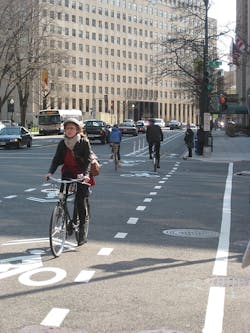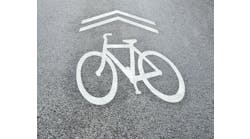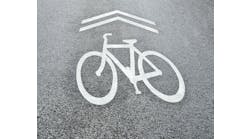Bicycling has been on the rise in communities across the U.S. As cities and towns grapple with high growth in dense areas, as well as challenging mobility demands, the demand for bikeable, walkable places is rising commensurately. Businesses are increasingly seeking out cities with multimodal infrastructure to remain competitive in a marketplace that values skilled workers. To make themselves more attractive to both, communities have begun investing in and promoting safe, bicycle-friendly street networks.
Bicycle commuting has increased by more than 60% since 2000, bringing the total number of bike trips up from 1.7 billion to more than 4 billion per year between 2000 and 2013. This increase occurred as high gas prices and the economic effects of the Great Recession pushed vehicle miles traveled to its lowest levels in decades, making bicycling a more affordable, attractive mode of travel. Along the way, communities of all sizes took a closer look at their transportation policies and infrastructure for people on two wheels, and began exploring the possibilities of refocusing streets theretofore devoted exclusively to cars into dynamic multimodal engines of economic opportunity. The ability to attract and retain businesses, retailers, and residents with safe, desirable, accessible communities and public spaces is driving demand for better bike infrastructure.
D.C.’s 15th Street NW.
Safe planning
While more and more people choose active transportation options, planners and engineers are increasingly looking for infrastructure improvements that provide safe travel for all road users. As bicycle trips have risen, so too have roadway fatalities and serious injuries for bicyclists resulting from car-bike crashes. A recent report from the Governors Highway Safety Association indicated that 2015 saw a 12% increase in cyclist fatalities, the largest such rise amongst road-user groups. For this growth in economic opportunities to be sustained, safer street designs for vulnerable road users are paramount. And communities are taking action: More than 30 U.S. cities and towns have adopted Vision Zero policies to define their transportation planning and policy-making. An overarching public policy that prioritizes human life over mobility, Vision Zero states that traffic fatalities and serious injuries are both preventable and unacceptable, and communities are seeking new infrastructure designs that prioritize safety.
Among the most significant new countermeasures in roadway design for the Vision Zero era is the separated bike lane. Separated bike lanes, which provide physical separation between motor vehicles and bicycles, are increasingly becoming the standard for safer street designs for people on bikes, in vehicles and on foot. According to industry coalition PeopleForBikes, cities and towns across the nation have doubled the number of separated bike lanes every two years since 2009.
Dedicated lanes
What makes up a separated bike lane? The primary distinguishing factor is physical separation from other road users for space exclusively dedicated to bicycling. That separation can take the form of a curb, plastic bollards or even parked cars. These separated facilities are typically located within the street next to the curb, but also can be located at sidewalk level, providing vertical separation. Separation is being extended to intersections as well, with new protected intersection designs that minimize conflicts for people walking, biking and driving through the most dangerous parts of streets. These intersections often provide separate bicycle signals, and traffic engineers have been developing new ways to detect, accommodate and delineate bicycle operations within the roadway. This investment in separated bicycle facilities comes as researchers are finding more conclusive evidence that these street designs increase safety for all users, regardless of mode.
According to a growing body of research, streets with separated bike lanes are safer for bicyclists, pedestrians and drivers, when compared to other street designs. Not only does the presence of a separated bike lane reduce the risk of injury for bike riders by 28%, these facilities’ shorter crossing distances reduce conflicts for pedestrians as well. New York City’s analysis of its protected bike lanes showed that every corridor in which they had been installed also saw significant reductions in pedestrian injury rates.
St. Paul, Minn’s Jackson Street.
Slow down
Reducing vehicle speed has been especially important for safety. The National Transportation Safety Board released a report in June 2017, highlighting the deadly effects of speed on transportation fatalities. The report states that speed was a factor in nearly as many traffic fatalities as alcohol from 2005 to 2014, and directly links higher speeds with increased rates of injury among all road users. By reducing vehicle lane widths, or even removing vehicle lanes to add bike facilities, streets become safer for everyone who drives, bikes or walks through corridors with separated bike lanes.
Research also has shown that both drivers and bicyclists clearly prefer streets with separated bike lanes. According to one study in the San Francisco Bay area, both bicyclists and non-bicycling drivers agreed that streets with defined space for both types of users helped increase predictable interactions with other road users, and decreased the stress of driving or bicycling near other road users.
An early example of a separated bikeway is the 15th Street NW separated bike lane in Washington, D.C. Located on a north-south street leading to the core of the capital’s central business district, the 15th Street cycle track was installed in 2010 as a pilot project. It has since become a permanent, two-way bicycle facility following the end of the District Department of Transportation (DDOT)’s pilot program.
The 15th Street separated bike lane was a groundbreaking project in many ways. As one of the earliest examples of separated bicycle facilities implemented in the public right-of-way, it helped dispel many of the existing notions about the safety effects of these facilities. Following the installation of the pilot facility, DDOT observed a 40% increase in bicycle trips on the 0.9-mile corridor, along with a 12% decrease in bicycle riders on the sidewalk. The outcomes also affected safety metrics for more than just bicyclists. In an analysis of peak-hour travel after the installation of the pilot facility, DDOT observed a nearly 60% decrease in speeding by motorists in the evaluation area, despite an additional 800 vehicles travelling through the corridor. When combined with the increase in trips by people biking and walking on 15th Street NW, the net public benefit of the pilot project amounted to more than $2.1 million when accounting for the reduction in serious injuries caused by crashes, and increased bicycle ridership.
Since the pilot, ridership has increased dramatically, with counts from 2013-2017 averaging around 1,400 bicycle trips per day. What’s more, this increase in the number of bicycle trips did not have a corresponding increase in bicycle crashes. According to DDOT data, bicycle crashes increased at one-third the rate of increase in bicycle trips, making 15th Street safer for a much larger number of users through the project corridor.
Westlake Crosswalk in Seattle.
Evolution of SBLs—Westlake
As concepts for safe bicycle facilities have developed, cities and communities are taking on unique safety challenges with groundbreaking new designs. The city of Seattle’s Westlake Cycletrack is one such example. Located along the shores of Lake Union, it was constructed in 2016 to provide a dedicated space for the high number of commuting bicyclists who were using a 1.2-mile-long municipal parking lot to connect from a shared-use trail to the downtown core of the city.
The unpredictable interactions between motorists and bicyclists using the parking lot for very different purposes created a hazard for both groups with a long history of car-bike crashes in the area. In creating a wide, separate facility that clearly delineated where people would ride, the Westlake Cycle track reduced conflicts between drivers and riders, giving each space to operate safely and predictably in a key corridor for commuting downtown. The Westlake separated bike lane also features numerous marked pedestrian crossings and new signage, to highlight access points to the commercial, residential and recreational destinations along the lakeshore.
Evolution of SBLs—Jackson Street
Cities also are moving forward with projects that re-envision entire streets, increasing predictability and safety when the opportunity arises. In Saint Paul, Minn., a municipal utilities project gave the city an opportunity to rethink the design of a key downtown street to focus on user safety. They engaged in a ground-up reconstruction of the eight-block corridor in the downtown core, creating a sidewalk-level two-way separated bike facility that features permeable pavement, low-impact drainage design and clear separation areas for easier winter maintenance. The Capital City Bikeway’s Jackson Street segment was completed in October 2017 and is the first segment of what will be a multi-street downtown bikeways network called the Capital City Bikeway.
One of the notable safety elements built into the design of Jackson Street is in the enhanced signalization. Separated bikeways often require additional attention from traffic engineers, who are increasingly exploring the safety impacts of separated signalized phasing for different road users. The Jackson Street project features several new signalization patterns, conducted under the experimental supervision of the U.S. DOT’s Federal Highway Administration (FHWA). Separate signal phasing is an important way to further reduce conflicts between people biking and driving at intersections.
Additionally, the Jackson Street separated bikeway incorporated a number of innovative approaches to complying with the Americans with Disabilities Act. New street designs must often confront the challenges faced by people with mobility or visual impairments, and practitioners are frequently developing new approaches as projects are designed. As a sidewalk-level bicycle facility, Jackson Street was designed with more gradual ramps down to street level, to accommodate people in wheelchairs. Conflict zones where bicyclists, pedestrians and motorists interact are highlighted in green paint, and signage includes messages for all three users. It also includes detectable warning strips at intersections as well as clear transitions between street, sidewalk, and bike lane, using landscaped barriers between the sidewalk and bike lane areas to serve as guidance for people with visual impairments.
Separated and protected bikeways reduce fatalities due to car-bike incidents.
The importance of choice
In discussions of the safety of separated bikeways, an often-overlooked question is that of choice. The first indicator of safety is perception, and many people in cities across the country make their most important safety decision before they ever leave for their destination. The choice to walk or bike is one that is often made based on the feeling of safety, so one might conclude that if more people are choosing to walk or bike on a given street, that it has already had an impact on the safety of road users. On that count, separated bike facilities are very effective. According to a report from the National Association of City Transportation Officials, rates of bicycling on streets with separated bike lanes in seven U.S. cities increased between 21% and 171%. Future national design guidance must include perception data for safe bicycle facilities in all contexts, and continue to offer innovative engineering solutions that make travel safe for everyone who uses our streets.
The transportation networks of the future depend on planners and engineers of today to create safe street designs for people who walk, bike and drive in communities across the country. If communities are successful, the benefit provided by roads engineered to be safe for all modes extends far beyond transportation. The Chicago Department of Transportation reported that their investment in a separated bikeway network helped the city see a 54% decrease in bicycle crashes, and a 60% decrease in bicyclist fatalities and serious injuries. The reduction came as bicycle trips increased by 167% from 2005-2015.
Safe street designs for multimodal transportation networks are one of the best places for communities to invest their efforts, because they create places where people can travel comfortably and easily. The increase in safety for people travelling across all modes makes separated bike lanes an important tool for this effort. Transportation planners and engineers are the stewards of our roads and bridges in the future, and should be mindful of including them.



